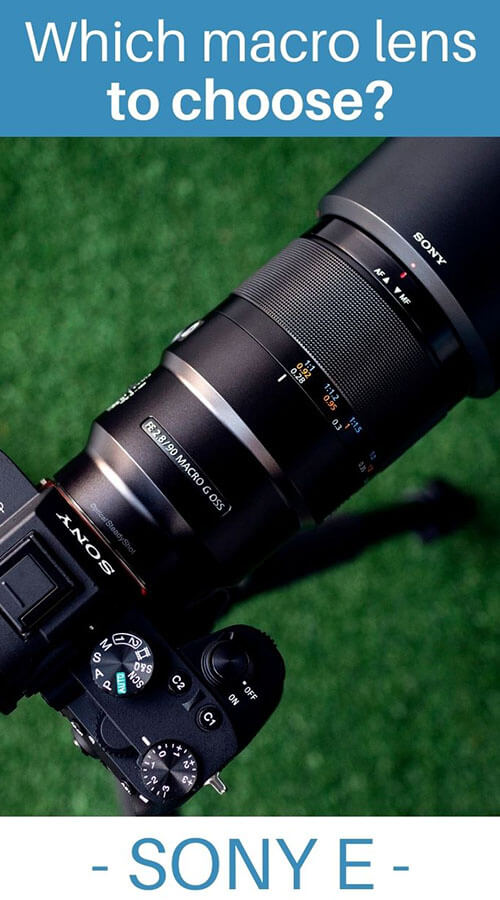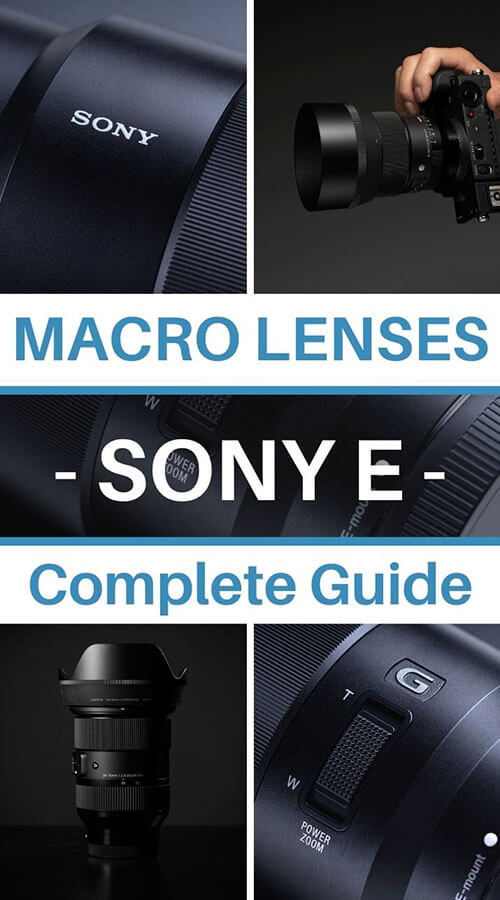Best Sony macro lenses for E-mount
Last update: 05/12/2024
Our blog continues to grow thanks to you, our readers. This post may contain affiliate links, which means we can earn a small commission if you make a purchase through them, at no extra cost to you. This helps us to continue to bring you more and support our work!
Are you passionate about the “small” world? Macro subjects are everywhere, and getting unusually close to these small subjects can be beautiful and fascinating! You can take pictures of this tiny world with an ordinary camera lens, but if you want to get as close as possible to various subjects, a macro-specific lens will come in handy.
So, to continue our series of articles on lenses for Sony mirrorless cameras, today I’m trying to guide you through the best Sony E-mount macro lenses. Because if your current lens doesn’t focus accurately enough to magnify a subject in the sensor, then a specialized macro lens will allow you to focus on a wider variety of subjects with a different and very precise design. In this article, I’ll detail the best autofocus lenses for full-frame and APS-C sensors, as well as the best manual options in a comparison table.
Several of the lenses mentioned in this article are among the best current Sony lenses. But don’t worry, most macro lenses have also a general use depending on the focal length you choose, whether it is for portrait, street, or landscape photography…
If you already have a clear idea of the focal length you are interested in, you can read our articles dedicated specifically to 24mm, 35mm, 50mm or 85mm focal lengths to help you in your choice of Sony mirrorless lens.
Which Sony Macro Lens to Choose: My Personal Recommendations
Looking for the best macro lens from Sony? Here’s a quick guide to the best options to suit all budgets. For more in-depth information, read our lenses reviews.
Choosing a Sony lens is still pretty straightforward in my eyes. Here’s my opinion in a nutshell: if you’re looking for a macro lens for your Sony full-frame body and your budget isn’t an issue, then the Sony 90mm f/2.8 Macro G OSS is undoubtedly the best on the market. If your budget is tighter and you’re looking for a more versatile lens, for example for portraits, I’d recommend the Sigma 105mm f/2.8 Art FE. If your budget is even tighter, the Sony 50mm f/2.8 FE Macro would be your best choice. For those who don’t mind manual focusing, the Laowa 100mm f/2.8 2x Ultra Macro APO is also an excellent option, offering very good build quality and high quality images for under €500.
For Sony APSC owners, I would definitely go for the Sony 30mm f/3.5 Macro. However, I wouldn’t overlook the Laowa CF 65mm f/2.8 CA – Dreamer Macro 2X, which offers better quality than the Sony, but with manual focus, which is generally acceptable for macro photography.
Best Sony Macro lenses with Autofocus
I propose you here what I consider as the best macro lenses in Sony E mount for full frame and APS-C sensor. This ranking takes into account the different criteria mentioned above, but also the price. So, you’ll found for your mirrorless camera :
Sony macro lenses for full frame sensors
I decided to make it easier for you by breaking down the best Sony macro lenses according to whether they feature autofocus or not. Because some people struggle with manual focus lenses, I thought it would be relevant to split them up. However, many macro enthusiasts prefer to use only manual focus for more accuracy. In short, you will find for Sony full frame cameras :
Best Sony Full frame macro lenses with autofocus
Here are, first, the 5 best macro lenses with autofocus for full frame sensor. You can also have a look at our complete page listing all Sony lenses for FE (Full frame).
- Sigma 105mm f/2.8 Art pour Sony
- Sony 90mm f/2.8 Macro G OSS
- Tokina Firin 100mm f/2.8 DG Macro
- Sigma 70mm f/2.8 DG Macro Art
- Sony 50mm f/2.8 FE Macro
As you can see, these are only prime (no zoom-lens) and constant aperture lenses.
The table below compares all the main characteristics of the best Sony macro lenses mentioned below.
In the meantime, here’s what you can remember about these different macro lenses.
1. Sigma 105mm f/2.8 Art for Sony
| Specifications | Visual |
|---|---|
| 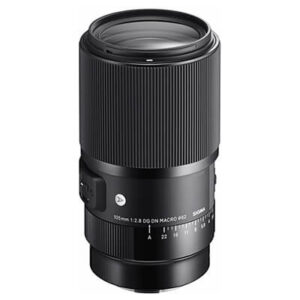 |
The Sigma 105mm f/2.8 Macro, Sony’s longest focal length for now, is a very nice lens that will not disappoint. It has a solid construction, resistant to dust and humidity, as well as an autofocus, but it lacks image stabilization and focus distance indication, which will be observed directly on the screen. All this for a weight (715g) and a size (13.4cm) fairly well controlled.
There is a diaphragm ring and several shortcuts around the edge of this fixed focal length. The Sigma 105mm is a 1:1 lens with a minimum focusing distance of 29.5cm. Thanks to its 9 apertures blades and focusing distance, we get a beautiful bokeh and the subject is easily highlighted. Some reviews indicate that the autofocus of this prime lens could be a little faster. The optical quality is excellent from full aperture and up to f/5.6, while the optical defects are well handled.
Despite an imperfect autofocus, it is hard to ignore the superb quality of this 105mm f/2.8 DG DN MACRO Art, which even has some advantages over the Sony 90mm. On one hand, it’s a little more affordable while delivering better image quality, and on the other, its extra 15mm reach gets you even closer to your subjects. In my opinion, it is just the most versatile and best quality lens for macro photography you can find today.

2. Sony 90mm f/2.8 Macro G OSS
| Specifications | Visual |
|---|---|
| 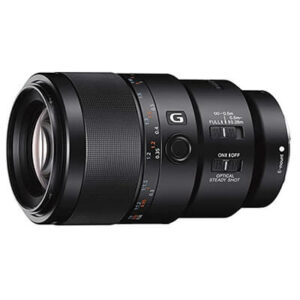 |
The Sony FE 90mm f/2.8 Macro G OSS lens is one of the best lenses ever made by the brand. With a dust and moisture resistant construction and its 13cm length for a weight slightly exceeding 600g, this 90mm is quite impressive.
A manual focus system is available by pulling the focus ring, which is comfortable, smooth, and accurate. The autofocus is of an exemplary speed. This lens also has built-in optical stabilization, which makes it easy to get very sharp images at slower shutter speeds. The reproduction ratio is classic, at 1:1, and the focus will be made at 28cm from the subject. The 9-apertures blade produces a very soft and pleasant bokeh.
The image quality is impressive, with a lot of details from the center to the edges, and this from f/2.8 to f/16. Chromatic aberrations are very well controlled. There is a slight vignetting at the largest apertures and a very slight distortion.
It’s hard not to recommend this beautiful Sony 90mm, both for the image quality and for all the options offered, not to mention the fast autofocus. In short, you can’t really be disappointed with this choice, but obviously, capturing images with this lens comes at a price!

3. Tokina Firin 100mm f/2.8 Macro
| Specifications | Visual |
|---|---|
| 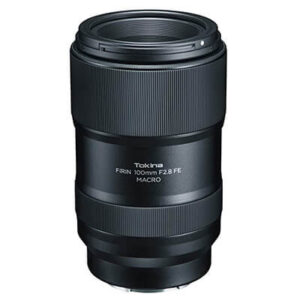 |
Tokina released a new Firin 100mm f/2.8 Macro lens for macro and portrait photography in April 2019. Design-wise, this Tokina is well balanced with a weight of 570g and a length of 12.3cm. On the other hand, no optical stabilization or all-weather construction.
It is capable of shooting at a minimum distance of 30cm, with a reproduction ratio of 1:1. A distance scale and reproduction ratio indication on the lens allow users to easily find their way around. It also has a large, smooth, and precise focus ring, but no AF/MF switch. Thanks to a relatively bright f/2.8 aperture and the 9-blade diaphragm, the lens produces a soft bokeh.
The image quality is very good, especially from f/5.6, and the color rendition is beautiful. Very little vignetting and distortion, however, chromatic aberrations and flare resistance are behind other lenses. Autofocus is said to be a bit slow and noisy.
This Tokina Firin 100mm is a good macro lens for tighter budgets. You’ll have the essentials: very good sharpness, nice color rendition and superb background blur.

4. Sigma 70mm f/2.8 DG Macro Art
| Specifications | Visual |
|---|---|
| 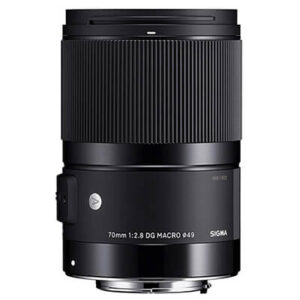 |
If you are looking for an alternative to the excellent Sony 90mm, that is to say a high-quality macro lens but at a more reasonable price, then the Sigma 70mm f/2.8 Art is for you. Like all Sigma Art lenses, it is very well built but not the most compact: 13cm for 622g, heritage of its DSLR design.
With no internal focus, the lens extends more than about 5cm when used at its shortest focusing distance. It has a nice, wide focus ring. A selector switch allows you to quickly switch between AF and MF. Focusing up to 25 cm to achieve a maximum magnification of 1:1 gives it the deserved title of macro. Not to mention its 9-blade construction which makes the bokeh extremely smooth.
It produces very sharp images across the frame, and chromatic aberrations are well controlled, as is distortion.
Of course, no lens is perfect: no stabilization, a bit slow autofocus, and with this focal length, you’ll have to get very close to your subject to get 1:1 magnification, so there’s a risk of casting a shadow or making your subjects run away. But for the price, you can’t go wrong with this lens!

5. Sony 50mm f/2.8 FE Macro
| Specifications | Visual |
|---|---|
|  |
If you want a native FE Sony macro lens, with good build quality and a minimal size (7cm for 236g), then you can opt for this 50mm.
Among the many advantages of this lens is a distance and magnification scale indicator printed. You also get a focus range limiter. The 1:1 magnification ratio is at a minimum focusing distance of 16cm. However, the working distance is only 45mm from the front of the lens, which can be difficult for some shy subjects, and you really risk casting shadows.
The lens is surprisingly sharp. At f/2.8, it’s sharp in the center of the frame, but the corners are a bit softer. However, at f/5.6, the image gets really sharp throughout the frame. Flare resistance and distortion are very well controlled.
It’s a bit of an expensive lens, but that’s to be expected for such a high-quality Sony lens. The Sigma 70mm will, I think, be a better value. Unless you prefer the 50mm focal length, which will be more all-purpose.

Here is a summary table that compares the main specifications of the above-mentioned Sony macro lenses for full frame sensors.
| Best macro lens for sony (with AF) | Focal length | Max. Aperture | D/L | Weight | Reproduction ratio | Min. focus distance | Ap. blades. | Best price |
|---|---|---|---|---|---|---|---|---|
| Sigma 105mm f/2.8 Art FE | 105mm | f/2.8 | 74 x 133,6mm | 715g | 1 :1 | 29,5cm | 9 | Amazon B&H |
| Sony 90mm f/2.8 Macro G OSS | 90mm | f/2.8 | 79 x 130,5mm | 602g | 1:1 | 28cm | 9 | Amazon B&H |
| Tokina Firin 100mm f/2.8 Macro | 100mm | f/2.8 | 74 x 123mm | 570g | 1:1 | 30cm | 9 | Amazon B&H |
| Sigma 70mm f/2.8 DG Macro Art | 70mm | f/2.8 | 70,8 x 130mm | 622g | 1:1 | 25cm | 9 | Amazon B&H |
| Sony 50mm f/2.8 FE Macro | 50mm | f/2.8 | 71 x 70,8mm | 236g | 1:1 | 16 cm | 7 | Amazon B&H |
Manual focus lenses for Sony full frame cameras
You will find below the manual focus lenses for Sony full frame cameras that I consider interesting to look at if you are looking for a macro lens. I obviously can’t detail every manual focus lens available for Sony (there are too many), but here are some interesting things to note for the ones I consider the best.
Characteristics of these lenses (and others not detailed) are given in the table below.
So here are the MF macro lenses I recommend for a full frame Sony camera:
Laowa 24mm f/14 2X Macro Probe
| Specifications | Visual |
|---|---|
|  |
I wanted to say a few words about this rather unique lens since the lens is 40cm long (!), which makes it usable in various places, even underwater since the end of the lens is specified as waterproof up to 20cm. Moreover, an LED light is already incorporated at the end of this lens. Note that this is a lens offering a 2:1 ratio.
The lens, packed in a metal case, offers excellent build quality. The image quality at f/14 (the minimum aperture of this lens) is already very good, but if you close to f/22, you’ll get even better results.
Finally, macro fans will love this very special lens, even if they will have to use it with a tripod!

Laowa 25mm f/2.8 2.5-5X Ultra Macro
| Specifications | Visual |
|---|---|
|  |
Let’s stay with Laowa and talk about this very special lens since it allows you to get a 2.5 to 5x magnification ratio. Concretely, you will be able to see a subject at more than 5 times its real size on your image! The lens does not allow the transmission of EXIF and (fun fact) does not have a focus ring, but a magnification ring allowing you to go from x2.5 to x5.
This lens should be considered as an “extreme” macro lens that allows huge magnification. In fact, it is a lens that will require practice and especially the use of focus stacking, the combination of several photos with different ultra short areas of focus at this magnification level to increase depth of field. A tripod will also be mandatory. Clearly, we are far from a classic macro lens, but magnification experts and fans will love it!

Laowa 60mm f/2.8 2X Ultra-Macro
| Specifications | Visual |
|---|---|
|  |
Again from Laowa, this 60mm f/2.8 offers more classic macro possibilities although the lens allows a 2:1 ratio! As always with Laowa lenses, the build quality is very good and the lens has two rings for aperture and focus. The minimum focusing distance is 18.5cm.
The image quality is already very good at full aperture (which is not important for macro photography…) and improves when closing a little. However, we note a very high distortion (which can be corrected in post processing in Lightroom) and a very strong vignetting. For those interested in the “very small world”, this lens might clearly be considered. If you are interested in this focal length, don’t hesitate to look at the excellent Voigtlander Macro 65mm f/2 APO-Lanthar.

Laowa 100mm f/2.8 2x Ultra Macro APO
| Specifications | Visual |
|---|---|
|  |
I end here the Laowa tour with a more classic focal length, this Laowa 100mm. Like all Laowa, the design of this lens is very good, all metal (but still no EXIF transmission). The lens has a focus ring and an aperture ring without clicks.
The image quality is very good over the whole field from full aperture, but still below what you can get with the excellent Voigtlander 110mm f/2.5 Macro APO-Lanthar. We observe very few optical defects. In the end, this 100mm from Laowa remains a very good option if you are looking for a focal length of this type without spending (at least) twice as much for the Sony 90mm (with AF) or the Voigtlander 110mm (MF only).

Voigtlander Macro 65mm f/2 APO-Lanthar
| Specifications | Visual |
|---|---|
|  |
I now move on to a brand that perhaps people are less familiar with, Voigtlander. However, this German brand offers beautiful high quality lenses, with manual focus. This 65mm offers an incredible build quality, all metal, with a thin aperture ring at the front of the lens and a focus ring with very large indentations, for a perfect handling. The lens offers a 1:2 magnification ratio, which will be enough for many people.
The image quality is exceptional from full aperture (f/2) on the whole image, even if we do not use a large aperture in macro photography. Optical defects are overall very well managed. Finally, this Voigtlander remains for many an exceptional lens, even if it does not have autofocus or weather-sealing. The lens remains quite imposing (625 g).

Voigtlander 110mm f/2.5 Macro Apo-Lanthar
| Specifications | Visual |
|---|---|
|  |
I end my recommendations of manual focus lenses for Sony full frame cameras here with this Voigtlander 110mm f/2.5. This is the second lens of the brand, specialized for macro photography, but this one offers the famous 1:1 magnification ratio. As for the 65mm, the build quality is excellent, made of metal with the two needed rings (aperture and focus). Note that the lens extends very strongly in macro position.
The image quality is excellent from f/2.5 (full aperture) and even better on the whole image at f/4. The sharpness is equal to the excellent Sony 90mm f/2.8 macro G OSS, or even better. However, the focus ring is said to be better with a very precise rotation of 360° possible from 35cm to 70cm from the subject. Optical defects are almost non-existent. In the end, we come close to the perfect lens, even if some will surely prefer the 90mm Sony, more versatile with its autofocus. But for pure macro work, it is clearly a lens to consider.
Here are the summarized characteristics of the above mentioned lenses (at the beginning of the table) as well as other macro options with manual focus that I did not detail.
Here are the summarized characteristics of the above mentioned lenses (at the beginning of the table) as well as other macro options with manual focus that I did not detail.
| Macro e mount lens with Manual focus (MF) | Max. aperture | Dimensions (D/L) | Weight | Reproduction ratio | Min. focus distance | Best Price |
|---|---|---|---|---|---|---|
| Detailed macro lenses | ||||||
| Laowa 24mm f/14 2x Macro Probe | f/14 | 38 x 408 mm | 474g | 2 :1 | 20cm | Amazon B&H |
| Laowa 25mm f/2.8 2.5-5 x Ultra Macro | f/2.8 | 82 x 65mm | 400g | 2,5-5 :1 | 17,3cm (5x) – 23,4cm (2,5x) | Amazon B&H |
| Laowa 60mm f/2.8 2x Ultra Macro | f/2.8 | 70 x 95mm | 503g | 2 :1 | 18,5 cm | Amazon B&H |
| Laowa 100mm f/2.8 2x Ultra Macro APO | f/2.8 | 72 x 155mm | 638g | 2 :1 | 24,7cm | Amazon B&H |
| Voigtlander 65mm f/2 Macro APO-Lanthar | f/2 | 78 x 91mm | 625g | 1 :2 | 31cm | Amazon B&H |
| Voigtlander 110mm f/2.5 Macro Apo-Lanthar | f/2.5 | 78,4 x 99,7mm | 763g | 1 :1 | 17cm | Amazon B&H |
| Other non-developed macro lenses | ||||||
| Laowa 15mm f/4 Macro | f/4 | 64,7 x 83,8mm | 410g | 1 :1 | 16cm | Amazon B&H |
| Mitakon 20mm f/2 4.5X Super Macro | f/2 | 62 x 60mm | 230g | 4,5 :1 | 20cm | Amazon B&H |
| Mitakon Zhong Yi 85mm f/2.8 1-5x Super macro | f/2.8 | 67 x 122mm | 750g | 5 :1 | 10cm (5x) – 27,2cm (1x) | Amazon B&H |
| Meike 85mm f/2.8 | f/2.8 | 64 x 117mm | 500g | 1,5 :1 | 8,5cm | Amazon |
| Samyang 100mm f/2.8 ED UMC Macro (Rokinon) | f/2.8 | 72,5 x 120mm | 705g | 1 :1 | 30cm | Amazon B&H |
Sony macro lenses for APS-C sensors
If you have a Sony APS-C camera, I have made it easy for you by breaking down my recommendations into autofocus and manual focus (MF) lenses. When it comes to macro photography, a lot of people (including me) prefer to use manual focus for more accuracy. Even if it’s not for a professional use, I really invite you to look at these MF lenses listed below. So here it is:
The table below summarizes the main specifications of the two lenses discussed below.
Anyway, I invite you to have a look at our complete page listing all Sony and third-party lenses for Sony APS-C mount.
For your information, you can of course use macro e mount lenses for Full frame Sony cameras on APS-C camera, but you will have to apply a 1.5x crop factor. Then the 105mm lens will give a field-of-view of a 160mm lens on a APS-C. We actually wrote a full article explaining sensor size and how it influence our pictures.
Sony macro lenses for APS-C sensors with autofocus
If you have an APS-C camera, I suggest two specific lenses with autofocus.
The table below summarizes the main specifications of the two lenses discussed below.
Here is a short summary of what you can remember about these two macro APS-C lenses (with autofocus).
1. Sony 30mm f/3.5 Macro
| Specifications | Visual |
|---|---|
|  |
Released in 2011, this lens is starting to look a little outdated, but Sony has not yet decided to release a new macro lens for its APS-C sensor. The Sony E 30mm F3.5 Macro is an ultra-compact lens, measuring just 6cm in length and weighing 138g. This makes it very light, easy to carry and easy to use in the field, specialising in macro photography. With a price tag of around 220 Euros, it’s still a solid option without being out of pocket!
Made from good quality plastic, the lens is solidly built. There’s a high-quality manual focus ring on the barrel. The lens has 7 aperture blades, which makes for relatively nice bokeh. It has a 1:1 ratio, but the focusing distance of 9.5 cm makes it rather difficult to use. You have to be very close to the subject, which is difficult to do with live subjects, for example.
As for image quality, it’s very good in the center at full aperture, while the edges remain a little softer. Sharpness improves as you close the aperture to f/8, which is a good thing as you will always tend to close the aperture for macro photography, where you often want to maximise depth of field. Flare and chromatic aberrations are relatively well controlled, although they do appear in certain situations. Bokeh, while not perfect, remains soft and pleasing to the eye.
In conclusion, the Sony E 30mm F3.5 Macro isn’t perfect, but for those who want to try their hand at macro photography, particularly of still subjects, it’s an excellent choice, especially given its compact size and very affordable price.

2. Zeiss Touit 50mm f/2.8 Macro
| Specifications | Visual |
|---|---|
|  |
Here’s a nice lens Carl Zeiss provides with this 50mm. With a solid and elegant body, its 9 cm for 290g make it a compact lens.
It has an electro-mechanical focus ring and diaphragm. The reproduction ratio is 1:1 with a minimum focusing distance of 15cm. As always with this focal length in macro, you will have to be careful to avoid shadows on your subject. Its f/2.8 aperture and its 9-blade construction give you a very soft bokeh. The autofocus is a little slow.
The image quality is sharp in the center at full aperture, and the edges are a bit softer. Very little distortion, but chromatic aberrations could have been less pronounced.
You get the Zeiss name here, Zeiss performance, and a small, light, well-made lens. I recommend it if macro is your thing, or if you want a good 50mm lens for general use AND macro.

Here is the comparison of the lenses mentioned below.
| APS-C macro e mount lens | Focal length | Max. aperture | D/L | Weight | Reproduction ratio | Min. focus distance | Ap. blades | Best price |
|---|---|---|---|---|---|---|---|---|
| Sony 30mm f/3.5 Macro | 30mm | f/3.5 | 62 x 55,5mm | 138g | 1:1 | 9,5cm | 7 | Amazon B&H |
| Zeiss Touit 50mm f/2.8 Macro | 50mm | f/2.8 | 65 x 91mm | 290g | 1:1 | 15cm | 9 | Amazon B&H |
Manual focus lenses for Sony APS-C cameras
In addition to both autofocus lenses mentioned above, I thought it would be interesting to talk about two other lenses with manual focus dedicated to Sony APS-C sensors. One (the 7Artisans) remains a very interesting lens and offers a very good quality/price ratio and the last one is rather for “pure macro oriented” purists who want to go further in the world of macro and have a higher budget (Laowa). So here they are:
I have summarized the characteristics of both lenses in the table below.
7Artisans 60mm f/2.8 Macro Mark II
| Specifications | Visual |
|---|---|
|  |
While the first version of this 7Artisans was not very interesting, the brand has produced a much better version II. This manual focus lens is rather well built, lighter than in the version I (350g vs 550g), is quite compact and offers a reduced minimum focusing distance of 17.5cm. The filter size is 49mm.
Ergonomically, we can notice a large and rather well finished focusing ring and an aperture ring (without clicks). Be careful, EXIF are not transmitted to the camera with this lens. The image quality of this 7Artisans remains good at full aperture, but you will have to close to f/5.6 to get a more uniform image. The difference in sharpness compared to version I is apparently not huge. On the other hand, the Laowa 65mm listed below offers a much better image quality than this 7Artisans.
However, the results at a longer distance (for example for portrait photography) are significantly rather average and it is clearly a lens dedicated to macro photography. Some important optical defects, especially a very average resistance to flare.
In the end, especially considering the price (less than 200€), this 7Artisans lens is still a very good choice for a pure macro use if you have a limited budget. The Laowa below is much better, but at a much higher price.

Laowa CF 65mm f/2.8 CA - Dreamer Macro 2X
| Specifications | Visual |
|---|---|
|  |
This is definitely one of the best, if not the best, Sony APS-C macro lenses if you are not afraid of manual focusing, which is rarely a problem in macro photography. The reviews of this Laowa 65mm are really excellent. The lens, which does not transmit EXIF to the camera, is light (322g – a bit more than the 7Artisans mentioned above) and offers a minimum focusing distance of 16.5cm and a filter size of 52mm. Also, the lens provides a 2:1 magnification ratio!
The design quality is very good with a large focusing ring. It is rather similar to the Laowa 100mm, but it’s a dedicated full frame lens. As far as image quality is concerned, the sharpness is already excellent in the center at full aperture and closing at f/5.6 will result in a perfect and homogeneous image. We can note very few optical defects: no chromatic aberrations (hence the name “CA” in the name), no vignetting but a rather average resistance to flare. For portraiture, this 100mm equivalent will also be perfect and provides superb image quality at longer focusing distances.
To conclude, Laowa signs here a very nice lens, much better than the 7Artisans on all points. However, the lens is still more expensive (about 2.5x), but can also be useful for portraits. A lens that I particularly recommend.
Here is the comparison of the two lenses mentioned above:

Here is the comparison of the two lenses mentioned above.
| APS-C MF macro e mount lens | Focal length | Max. aperture | D / L | Weight | Reproduction ratio | Min. focus distance | Aperture blades | Best price |
|---|---|---|---|---|---|---|---|---|
| 7Artisans 60mm f/2.8 Macro Mark II | 60mm | f/2.8 | 60 x 74.5 mm | 339g | 1:1 | 17,5cm | 9 | Amazon B&H |
| Laowa CF 65mm f/2.8 CA – Dreamer Macro 2X | 65mm | f/2.8 | 57 x 100 mm | 335g | 2:1 | 17cm | 9 | Amazon B&H |
How to choose a macro lens?
Obviously, this type of lens is no exception to the rule: as for any specific lens, there are different criteria to consider when choosing a macro lens. If you want to know how to choose a lens in general, I let you refer to this article.
Although the sharpness of the lens is important in macro photography, there are three other very important aspects to consider when buying a macro lens.
Reproduction ratio
Also known as the “magnification ratio”, this refers to the ratio between the size of the subject projected onto your camera’s sensor and its real size. Macro photography generally involves shooting with a magnification ratio of at least 1:1. This means that the subject will appear full size on the camera sensor.
For example, if I shoot a 3 cm long butterfly, in a 1:1 ratio, its projection on the sensor will also measure 3 cm.
Note that while many lenses have the term “macro” in their name, this word only makes sense if the specifications reveal that they have a maximum magnification ratio of 1:1.
Minimum focusing and working distance
The minimum focusing distance is the minimum distance between the subject and the camera sensor, necessary for a proper focus. The working distance is the distance from the subject to the extremity of the lens.
As a general rule, in macro photography, we want a minimum focusing distance that allows to get close enough to the subject to get 1:1 magnification, but ideally with a working distance that doesn’t obstruct light from reaching your subject, doesn’t cast shadows, and doesn’t scare your subject (if you’re photographing living things).
Focal length
Deciding on the best focal length is, as always, part of the process of choosing a lens according to your needs.
- Short focal lengths (between 35mm and 60mm) will allow you to include more of the environment in your photo to display a wider perspective. They have a very short focusing distance (around 10 to 13cm), so you can be as close as possible to your subject, which is ideal when the latter is static.
- Standard focal lengths (between 70mm and 110mm) are the most versatile. The minimum focusing distance is longer (about 15 cm) and therefore offers a greater working distance at 1:1, which reduces some insect escapes. However, they do have narrower angles of view, so there is less background to incorporate into your image.
- Long focal lengths (150mm or longer) are heavy and bulky. You need to know how to use these lenses for macro photography. It is therefore rare to find these telephoto lenses among the best macro lenses.
For more details, I invite you to read our complete article on macro lenses. In this more in-depth article, I discuss the notion of maximum aperture for a lens of this type and the associated depth of field. I also discuss the point of buying a stabilized lens when many macro photographers routinely use a tripod.
And what about extension tubes?
If you are looking for a macro lens for your Sony camera, chances are you have heard of extension tubes. These are simply hollow tubes (without lenses) allowing you to reduce the focusing distance to your subject, thus increasing the magnification ratio. This is a very cheap and interesting macro accessory if you want to start macro photography with Sony on a tight budget.
The benefit of this solution (in addition to being cheap) is that it doesn’t change the image quality (since it’s a hollow tube), but the main drawback is the loss of light as you stack the tubes.
For Sony cameras, there are some reliable references of extension tubes. To mention only the best ones :
- Velo EXT-SFED : 10 and 16mm (B&H)
- FotodioX Macro Extension Tube : 7, 14 and 28mm (Amazon / B&H)
- FotodioxX Pro Extension tubes 10 and 16mm (Amazon / B&H)
- Kenko DG Extension: 10 and 16mm (Amazon / B&H)
- Viltrox Automatic Extension Tube: 10 and 16mm (B&H)
- MEIKE MK-S-AF3A Metal Auto Focus Macro Extension Tube (Amazon)
I hope this article about the best macro for Sony e mount will help you choose your new lens, and that images of flowers, insects, plants or drops of water will invade your memory cards! So, which lens do you think should be chosen? Personally, I can’t wait to see when Tamron will offer a macro lens for this Sony E mount. Tamron knows how to build macro lenses as they proved when they designed the Tamron SP 90mm F/2.8 Di MACRO 1:1 VC USD, a lens for DSLR cameras.
If you want to complete your Sony lens collection, don’t hesitate to check our article on the best Sony wide angle lenses.
See you soon,

Written by Sylvain PONS
I've been passionate about photography since 2010, learning as I went along. Today, I dedicate myself to guiding others in their choice of camera gear and sharing a variety of tips to improve their photography skills.
Despite our care, a mistake may have slipped into this article. If you find any, please don't hesitate to let us know so we can correct it as soon as possible and keep our information up-to-date!


